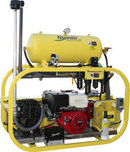p.s.:
But even if I look at the RIX :
That's 1 CFM/1 HP.
The Bauer PE 500 11 KW (15 HP) makes 18.5 cfm : or 1.23 CFM / 1 Hp.
Looks like the Bauer is more efficient .
Bottom line: only the wrong designed systems “saturates the membrane and gum up”.
Great post.
But not quite correct with the size of the motor fitted to a compressor being the same as the power required. But this is a very interesting angle and it does show how the motor size specification can be mis-read and how a more detailed explanation should be given to customers.
A 30cfm compressor at 3000psi would require 16-19 BHP or 14Kw
A 30cfm compressor at 3500psi would require 17-20 BHP or 14Kw
A 30cfm compressor at 4500psi would require 18-21 BHP or 15Kw
For all these applications the nearest commercial available size would be the 15Kw or 20HP
Now I didn’t want to drag Rix into this but Rix fits a 25HP or 18.5KW motor but is doing this for engineering practice and not to save $60 in price difference between a 20HP 15Kw and a 25HP 18.5Kw motor.
Now to compare all units properly you also have to consider the piston diameters, piston stroke and compressor RPM.
Bauer PE 680 (24cfm) is 1400 RPM
Rix 4VX4B-23NT3 (26cfm) is 935 RPM
Also if your production gas (nitrox) is being produced at pressure from the membrane
by using the LP membrane and increasing the inlet pressure to the HP compressor and reducing the size of the compressor piston diameters you can reduce the power required dramatically or increase flow or reduce RPM. Again using the 4VX as an example with the same motor but with different piston diameters to lower the RPM you get.
30 scfm with a 7psi inlet RPM 720 or
35 scfm with a 70psi inlet RPM 640 or
40 scfm with a 87psi inlet RPM 640 or
30scfm with a 40psi inlet RPM 350
Now if you really wish to compare we should also look at purity and running but if we compare like for like using your example but with a smaller but fixed output
The Bauer PE 500 11 KW (15 HP) makes 18.5 cfm : or 1.23 CFM / 1 Hp.
The Rix at 18.5 cfm would also require 11Kw 14.1 to 16HP at the 3000 to 5000psi range.
The difference is the Bauer needs 1170RPM to produce 18.5 cfm
The Rix only 500RPM
Clear (as mud) I guess LOL
Iain Middlebrook




